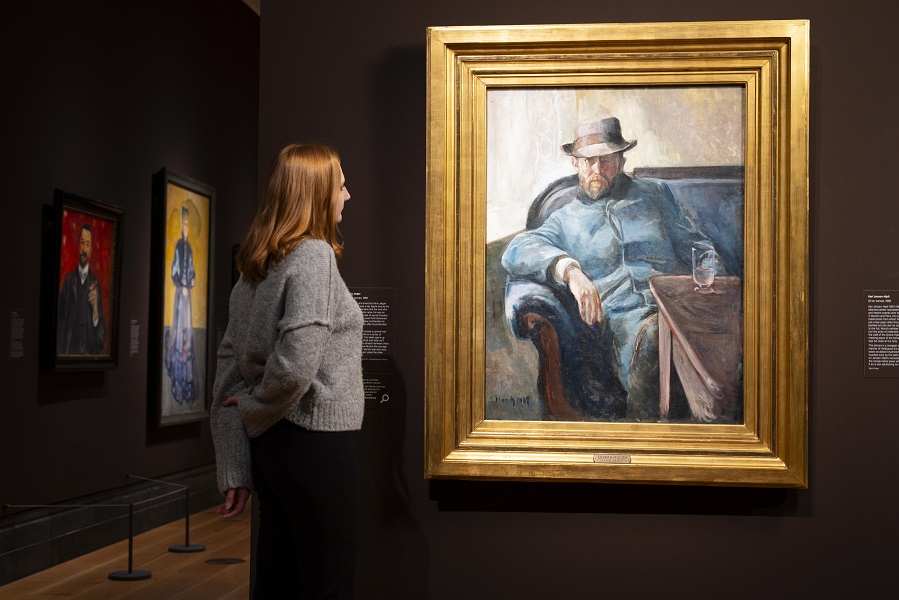 The first UK exhibition of portraits by Edvard Munch has opened at London’s National Portrait Gallery.
The first UK exhibition of portraits by Edvard Munch has opened at London’s National Portrait Gallery.
Featuring more than 40 works, Edvard Munch Portraits brings together key loans from major museums and private collections – a number never seen before in the UK – to explore the artist’s portraits of his family, his fellow bohemians, his patrons and his friends, from the 1880s to the 1920s. Often portrayed as an artist isolated from the mainstream, this exhibition presents Munch as a social being, exploring his wide network of creative contacts across Scandinavia and Northern Europe.
Perhaps most widely associated today with his 1893 work, The Scream, Edvard Munch (1863-1944) painted portraits as commissions and also for personal reasons, with many pictures also archetypes of the human condition despite being based on the direct observation of named individuals.
The exhibition opens with early family portraits, created during the 1880s and 90s. These intimate pictures, often painted on small pieces of card in a naturalistic manner, introduce concepts found throughout Munch’s body of work. Evening (1888), which shows the artist’s sister, Laura, a year before she was hospitalised for schizophrenia, captures her sense of alienation and can be seen as a prototype for Symbolist works made during the 1890s.
After leaving the family home in the mid-1880s to study art formally, Munch became part of the bohemian scene in Kristiania (Oslo). The artist’s interaction with bohemian circles in Kristiania, Paris and Berlin was vital for his artistic development, leading him towards a more expressive style he called ‘soul art’. In this section of the exhibition are portraits of, amongst others, the anarchist Hans Jæger, the writer and dramatist Stanislaw Przybyszewski and the lawyer Thor Lütken – this painting being displayed in the UK for the first time.
By the early 20th century, Edvard Munch was one of the most exhibited artists in Europe. In 1902 he returned to Berlin, where he won the support of a group of wealthy and influential collectors whose patronage further raised his profile. At this time, Munch began to take commissions, and in this section of the exhibition are portraits including German physicist Felix Auerbach, commissioned in 1906.
After collapsing from stress in 1908, Munch was admitted to a private clinic in Copenhagen, run by Dr Daniel Jacobson. The doctor requested a portrait and Munch chose to pose him in a powerful stance, with echoes of Holbein’s portraits of Henry VIII.
Munch settled in Norway following his recovery, his return facilitated by a group of men he called his ‘Lifeguards’ or ‘Guardians’. These close friends are celebrated in the final section of the exhibition, with key works including full-length portraits of the painter Ludvig Karsten and writer Christian Gierløff. Also featured are painting of Munch’s models such as Sultan Abdul Karem in Model with a Green Scarf – the only non-European sitter to be painted by Munch.
Dr. Alison Smith, curator of the exhibition, said: “Throughout his life, Munch sought to delve behind the masks of those he portrayed, using expressive paintwork to reveal inner feelings and motivations. This exhibition provides a unique opportunity to appreciate his work as a portraitist both in terms of his personal relationship with his sitters and with how he portrayed them.”
For further information: npg.org.uk
Image: A visitor observes Hans Jægar (1889) by Edvard Munch displayed as part of the exhibition Edvard Munch Portraits at the National Portrait Gallery © David Parry
Smith Greenfield is an independent insurance broker specialising in insurance for exclusive lifestyles and collectors of valuable objects including: art insurance, antiques insurance, jewellery insurance, watch insurance, vintage car insurance, fine wine insurance and more. To discuss specialist insurance for your lifestyle, please contact our Premier Client Adviser, Imran Moideen: imran.moideen@smithgreenfield.co.uk

